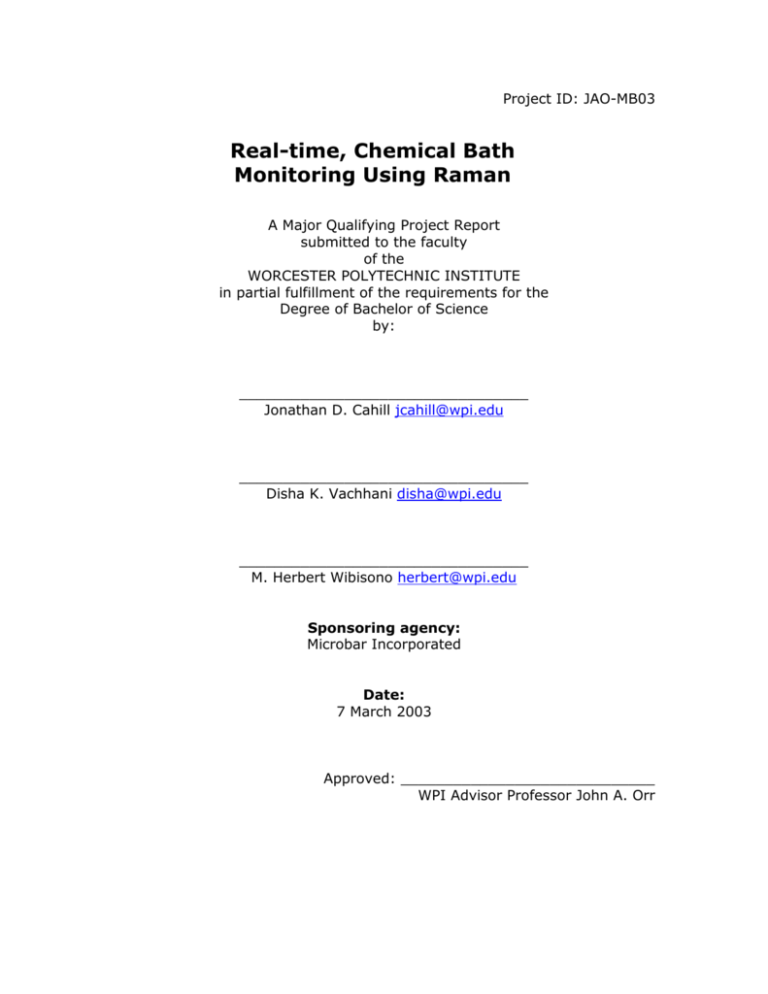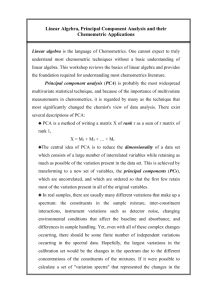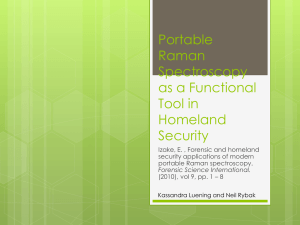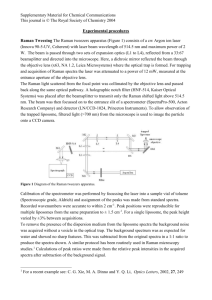Project ID: JAO-MB03 - Worcester Polytechnic Institute
advertisement

Project ID: JAO-MB03 Real-time, Chemical Bath Monitoring Using Raman A Major Qualifying Project Report submitted to the faculty of the WORCESTER POLYTECHNIC INSTITUTE in partial fulfillment of the requirements for the Degree of Bachelor of Science by: _________________________________ Jonathan D. Cahill jcahill@wpi.edu _________________________________ Disha K. Vachhani disha@wpi.edu _________________________________ M. Herbert Wibisono herbert@wpi.edu Sponsoring agency: Microbar Incorporated Date: 7 March 2003 Approved: _____________________________ WPI Advisor Professor John A. Orr Executive Summary Microbar Incorporated is in the business of providing equipment to hold and deliver chemicals used in the fabrication of integrated circuits. A feature Microbar would like to add to their equipment is the ability to monitor the concentrations of chemicals being stored in their equipment. In the integrated circuit manufacturing industry, tens of thousands of dollars can be lost if the chemicals being used are not present in the proper concentration. Current methods for obtaining chemical concentrations in use today have several drawbacks. These systems are slow, taking up to an hour per chemical, unreliable, and must be done outside of the bath solution. The goal of this project is develop a software system that can determine the concentration of chemicals in real-time to an accuracy of 5 percent or better without disturbing the chemicals being tested. It is also the goal of this project to make this system easy to use by providing a user-friendly interface. This project aims to outperform current methods using Raman Spectroscopy. Raman Spectroscopy is a measurement of the behavior of inelastically scattered light from a molecule. This measurement can be used to determine the chemical bonds in a substance and how frequently they occur in that substance. When a beam of light is directed at a substance, some of that light is scattered due to the vibrations in the molecules caused by the molecular bonds. This scattering can then be measured and observed as a spectrum, with peaks representing the bonds present in the substance. An example of a spectrum can be seen in Figure 1. 1 Figure 1 - Raman Spectrum As you can see from the figure, each bond in the chemical has its own peak. A very useful property of Raman spectroscopy is that the height of the peaks increase in a linear fashion as the amount of bonds that the peak represents increases. So, the higher the concentration of a chemical, the higher its corresponding peaks. This property is crucial to the use of Raman Spectroscopy for this project. If it is known that a certain peak in a spectrum corresponds to a particular chemical, the concentration of that chemical can be observed by watching that peak. There are other properties that give this method a distinct advantage over other methods of determining concentrations. First, Raman spectroscopy is fast, taking less than 5 minutes from the time a sample is taken to the time a concentration is calculated. Also, it is very accurate; it is possible to obtain results with less than a 3% error. Lastly, Raman spectroscopy can be done in situ, meaning that a probe can be put directly into a chemical bath to take a measurement without harming the bath in any way. There are two major parts to determining the concentration of chemicals using Raman spectroscopy. These parts are: developing a calibration curve from known results, and comparing unknowns to that calibration curve. To create a calibration curve, Raman spectra for samples with known concentrations are obtained. The heights of the peak associated with the chemical being tested are then plotted versus the concentration 2 associated with that height. A line of best fit for this series of points is then taken using a method called partial least squares. This line is now the calibration curve and is used to predict unknown samples. So to do this, the peak height of an unknown sample is taken and compared to the calibration curve to determine its estimated concentration. At Microbar, there is already a system in place that takes Raman spectra and analyzes it to determine the concentration of chemicals in a bath. The first step of this project is to observe that system, how it works, and what needs to be done to improve that system. The process involves three separate software packages and is very manual in nature. The user must use one software package to obtain a spectrum, export that data to another piece of software. This next software package is used to observe many spectra at once and obtain any raw data such as peak heights and peak locations. The spectrum is then exported to a third software package where calculations are done to determine chemical concentrations. This can be a very tedious and time-consuming process. The goal of this project is automate as much of that process as possible and attempt to bring it under one software package. To create this system, Matlab and some associated toolboxes were used. In particular, the PLS Toolbox created by Eigenvector Research Inc. was used as it provides the capability to perform partial least squares, a capability that basic Matlab does not have. Matlab does however provide the necessary mathematical capability while also providing a tool to create an easy to use interface. Model Creation There are three separate components to this program, each accessible to the user through a graphical user interface. The first of these three components is the model creation component. This component is where known samples are read in and used to create a calibration curve. A screen shot of the interface can be seen in figure 2. 3 Figure 2 - Model Creation Using this window, the files to be read in are displayed in the list box on the left. The user can add or remove files and assign a concentration to each file in the list box. There is also a drop down menu to specify any preprocessing method that the user wishes to use in creating the model. Preprocessing is manipulation of the data before analysis that improves the accuracy of the model. The preprocessing options include mean-center, auto-scale and normalize. The other box in this window is to specify the chemical being tested and the range where its corresponding peak lies in the spectrum. The first two options, hypophosphite and DMAB are two standard chemicals that are commonly tested and the selection of either of these will automatically fill in the range. When all the information has been entered, the user clicks the ‘create model’ button. This triggers the program to create the calibration curve and open a window that gives the user an idea of the quality of the model created. This window is called the verification window. A screenshot of this window can be seen in Figure 3. 4 Figure 3 - Verification This window gives the user an opportunity to verify the files entered and their associated concentrations, along with other relevant data about the model created. Three verification statistics are also displayed to help the user decide whether the model created is valid or not. These statistics are correlation, slope and y-intercept of the calibration curve. If the user is satisfied with the model, the save model button is clicked and the model is saved as a .mat file. Manual Prediction The next major component of the system is the manual prediction. In manual prediction, the user can select one or multiple files whose concentrations are unknown. A model to predict against is also selected and the predictions are made. A screenshot of this window can be seen in Figure 4. 5 Figure 4 - Manual Prediction As can be seen in the figure, this is a relatively straightforward window. The user-selected files to be analyzed are listed to the left and the model and its information are listed on the right. When the Predict button is clicked, the estimated concentrations are listed to the left next to the associated file. Automatic Prediction The last major component of this system is the automatic prediction component. This component is designed to monitor a bath for long periods of time with no interaction from the user. The user points the system to a location to which the spectrum file will be output, the model to predict against, and a sampling period, and lets the system run until the bath reaches an unacceptable level. A screenshot of this window can be seen in Figure 5. 6 Figure 5 - Automatic Prediction The other feature of this component is the quality feature. The user can enter a target concentration and limits for warning and alarm conditions. If these limits are reached, the user is notified with a warning message, an audible alarm and/or an email message. The right side of the window is dedicated to a plot of the concentration over time. The target, warning, and alarm limits are also plotted as straight lines so it is easy to see where the bath stands in relation to acceptable levels. Results To assure that the system to be implemented was accurate, a series of tests were run. These tests compared the method currently used by Microbar, a standard curve fitting algorithm using only Matlab functions, and the algorithm using the PLS toolbox functions. A model was created with 55 spectrum files with known concentrations using all three methods. Twentyfive unknown samples were then entered and the prediction results were compared. The results can be seen in Figure 6. 7 Samples A(0105) B(0610) C(1115) D(1620) E(2125) Actual Matlab Ave Pred Old Method Ave Pred PLS Ave Pred Matlab Ave Error (%) Old Method Ave Error (%) PLS Ave Error (%) 23.35 22.164 22.54 22.66 5.08 3.45 2.96 20.4 20.466 20.57 20.56 0.32 0.84 0.79 20.49 20.47 20.69 20.57 0.10 0.99 0.41 21.1 20.49 20.63 20.70 2.89 2.24 1.91 21.67 21.53 21.68 21.58 0.65 0.07 0.42 1.51 Table 1 - Comparison of Results 1.27 1.08 Total Average Error As you can see from the table, the unknown data consisted of 5 sets of 5 unknown spectra with the same concentration. PLS outperformed Matlab alone and the currently used method in both average error and worse case error. From this set of tests, and others like it, the method that was decided on was the method using PLS functions. With this data the user can be confident that the results produced using this system will be very accurate. Conclusions The goal of this project was to develop a system to create calibration curves and predict unknowns that was easier to use and more accurate than the system currently in place. The results appear to suggest that this goal has been achieved. This system has consolidated the uses of two programs into one. This one program is easier and faster to use than the previously used programs. Also, the target error limit determined at the outset of 3 percent has also been obtained. These achievements along with clear explanations of how the algorithms were written will insure that this system and the development of this project at Microbar Incorporated will continue in the future. 8







